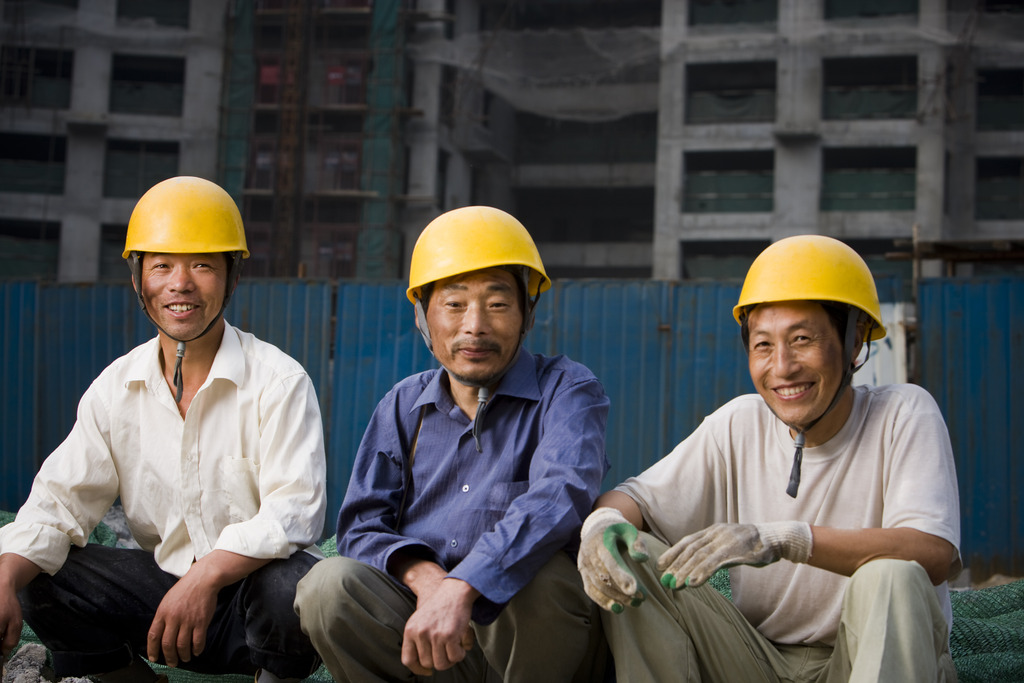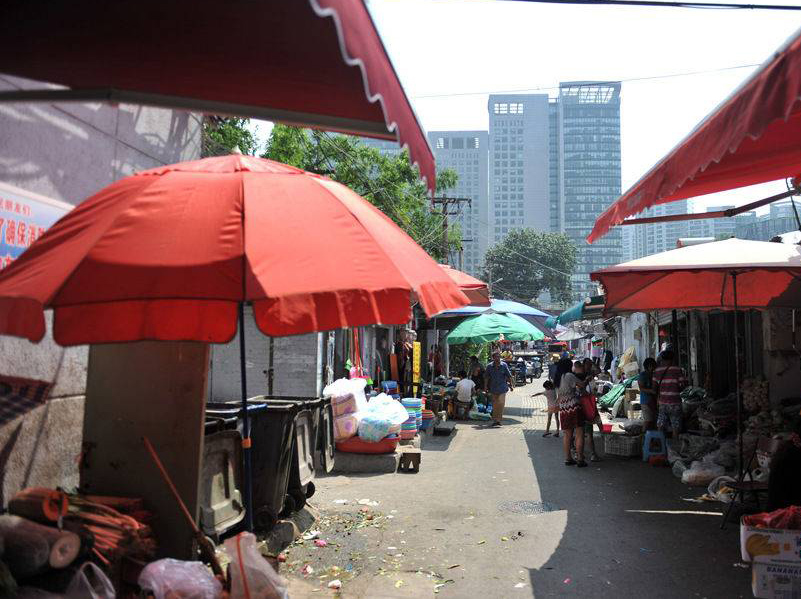Urbanization poses new problems for city migrants

Migrant workers employed in the construction industry are a large group of “urban villagers.” Their urbanism is weak with few opportunities to come into contact with urban natives.

Photo shows a glimpse of an “urban village” in Beijing. Most “urban villagers” are migrant workers who hold on to their rural lifestyles in cities.
Some problems with the hukou (household registration) system voiced over many years by academic and political observers were resolved following the Opinions on Further Promoting Household Registration System Reform issued by the State Council in July 2014. However, as China’s urbanization still has a long way to go, a new problem has emerged amid the ongoing boom of “urban villagers.”
The “Urban villager” is an important concept in urban sociology. The term refers to migrant workers living in urban areas and working in non-agricultural fields. While they share urban public services, they haven’t made completed transitions in terms of identity and lifestyle. They are the direct consequence of urbanism lagging behind urbanization.
Four types of urban villagers
Dispossessed farmers are the first large group of urban villagers in China. From the perspectives of geography (living in cities), economics (non-agricultural employment and economic strength) and politics (citizen identity), dispossessed farmers are urban citizens. However, they are still rural citizens from a sociological perspective.
Change from agricultural to non-agricultural status is not an initiative but passive and even compelled choice for dispossessed farmers. They are forced to accept urban lifestyles amid industrialization and urbanization without any mental preparation. It is inevitably difficult for them to adapt and integrate to urban life.
Many dispossessed farmers don’t live in urban communities with unified planning. They still live in original villages, all or part of which have been surrounded by cities. This is the phenomenon of “urban villages” that has been widely studied by academia over the past decade.
The “floating population” represents the second large group of urban villagers. Generally speaking, urban villages are all agglomerations of the floating population. The population in urban villages is mainly composed of locals and migrants, with the number of the latter far surpassing that of the former.
The word “village” is used to summarize the characteristics of the floating population agglomerations, the most famous of which is “Zhejiang village” in Beijing. Similar to “Zhejiang village,” there are also villages for natives of the Xinjiang Uyghur Autonomous Region and Anhui, Henan and Fujian provinces in Beijing. There is a “Henan village” in Nanjing, Jiangsu Province, and a “Xinjiang village” in Guangzhou, Guangdong Province. A large number of such “regional villages” can be seen in large-and medium-sized cities nationwide.
Migrant workers employed in the construction industry are the third large group of urban villagers. They have entered urban life, staying in temporary living quarters at urban construction sites. Their urbanism is weak, with few opportunities to come into contact with urban natives. They are urban villagers who are closer to rural natives.
Migrant workers who live in dormitories form the fourth large group of urban villagers. These dormitories are generally located in industrial zones and factories around cities, far away from urban residential areas, commercial and trade zones, and leisure and entertainment areas.
Dormitory walls and strict work and rest systems have restricted living spaces of migrant workers. They have limited opportunities to communicate with people other than workmates, and they tend to retain local countryside customs.
Rural lifestyles in cities
Urban villagers typically hold on to their rural lifestyles in cities. They mainly communicate with fellow villagers rather than other urban dwellers. The “hometown” complex has become the main link of their social connections. Locals in urban villages build houses haphazardly for the purpose of pocketing compensation for lost land.
Migrant workers engage in various businesses to earn a living in urban areas. People from the same hometown may collaborate for a common business, forming chains of employment. Floating population agglomerations have evolved into villages of fellow villagers. There are 643 such villages in Shenzhen, Guangdong Province, where 1.2 million people from Sichuan Province have formed dozens of “Sichuan villages.”
To cope with challenges of urban culture, migrant workers tend to live in urban villages where landscapes and customs are more or less similar to those of their hometowns. This allows them to forge a stronger psychological connection and better integrate into their new environment.
To cope with challenges of local culture, migrant workers tend to copy and recreate villages similar to their hometowns in inflow areas with their fellow villagers. Locals may even withdraw, making the living environment of migrant workers even more like villages in their hometowns. This allows migrant workers to mimic their original rural lifestyles and cultural patterns in cities. As a result, villages at risk of decline have witnessed a relative revival in urban areas.
Changes in ideas, behavior
Based on global experience, urban villagers are social groups emerging in the process of urbanization. Characterized by transition, this group will exist for a long time. Disappearance of urban villagers will be a long gradual process. Emerging with urbanization, urban villagers will not disappear with the fulfillment of urbanization. The end of urban villagers usually lags far behind the process of urbanization.
The phenomenon of “urban villagers” described by Herbert Gans in his book The Urban Villagers (1962) widely appeared in the US amid rapid urbanization at the end of the 19th century and beginning of the 20th century. Clusters of urban villagers didn’t disappear until the 1960s in the US. It is predicted that China’s urbanization, based on population statistics, will come to an end in the next 10 to 20 years. However, it is predicted clusters of urban villagers will remain widespread in China for the next 50 to 100 years.
Studies have found that involution of the new generation of migrant workers in social identity, social communication, cultural and political life, and emotional support is being constantly intensified. Urban society may enter the state of class division and isolation.
It may break up into quantities of relatively insular groups, with the risk of social instability and even turbulence. Two groups (natives and outsiders) in Dadun village of Xintang town, Guangdong Province clashed on June 11, 2011 following long-term tension between the two sides in the urban village.
The rate of urbanization only reflects the quantity and scale of urbanization. Only the complete transfer of migrant farmers and the quality of new citizens can comprehensively reflect the quality of urbanization. The concept of human-centered urbanization draws our attention from aspects related to materials such as urban expansion, estate development, image project, industrial development and economic scale to people-the subjects of urbanization. This means tremendous progress or wisely taking the right path of urbanization. However, the intact meaning of human-centered urbanization should be fully understood.
Human-centered urbanization includes two connotations: population urbanization and personality urbanization. The former refers to the process of migrant farmers breaking through limitations of the urban-rural dual social structure, striving for equal status with urban residents, obtaining legal urban status and equally sharing urban public welfare. The latter means the process of migrant workers gradually accepting urban lifestyles, changing their ideas and behavior patterns, or the process of urban villagers gradually disappearing.
It is harder to realize personality urbanization compared to population urbanization. Population urbanization is an overt issue that can easily capture the attention of society, while personality urbanization is a latent issue that cannot draw the attention of the government and academia.
If this issue cannot be effectively resolved, the problem of semi-urbanization will remain unresolved and it will be difficult to truly achieve urbanization. Personality urbanization should be put on the agenda after the resolution of population urbanization or in the process of population urbanization being resolved.
Wang Xingzhou is an associate professor from the Department of Sociology and Social Work at Sun Yat-Sen University.
